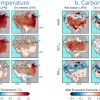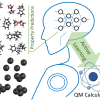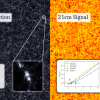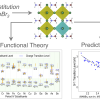Science Vignettes
Amazon Soil Moisture Impact on Carbon Dioxide Emissions
Soil moisture variability intensifies and prolongs eastern Amazon temperature and carbon cycle response to El Niño-Southern Oscillation The Science During El Niño events, atmospheric teleconnections with sea surface temperature (SST) anomalies in the equatorial Pacific cause higher temperatures and reduced rainfall in the Amazon, leading to increased CO2 emissions. While some of the temperature increase results directly from the SST-atmosphere teleconnection, drier soil resulting from… Read More »
DOE Models Simulate Antarctic Ice Sheet Evolution
Ice sheet models developed under a DOE SciDAC project and run at NERSC have contributed to three international model intercomparison projects focused on assessing the future evolution of the Antarctic ice sheet. Read More »
Enabling Thermochemistry Estimation using Deep Learning
MIT researchers developed an automated system to continually perform quantum chemistry calculations and use the results to continually retrain a deep learning model for predicting the thermochemistry, i.e., enthalpy of formation, entropy, and heat capacities, of complex polycyclic molecules. A novel approach for estimating uncertainties in these predictions was used to identify which new molecules should be refined with quantum chemistry and added to the training data set. NERSC resources enabled performing many quantum chemistry calculations automatically and in parallel. Read More »
Mapping Neutral Hydrogen in the Early Universe
Researchers at Berkeley Center for Cosmological Physics (BCCP) developed a model that produces maps of the 21cm emission signal from neutral hydrogen in the early universe. Thanks to NERSC supercomputers, the team was able to run simulations with enough dynamic range and fidelity to theoretically explore this uncharted territory which contains 80% of the feasibly observable universe by volume and holds the potential to revolutionize cosmology. Read More »
Machine-Learned Impurity Level Prediction in Semiconductors
Argonne National Laboratory (ANL) researchers ran high-throughout atomistic simulations on NERSC supercomputers and generated comprehensive computational datasets of impurity properties in two classes of semiconductors: lead-based hybrid perovskites and Cd-based chalcogenides. These datasets led to machine learned models which enable accelerated prediction and design for the entire chemical space of materials and impurities in these semiconductor class. Read More »












